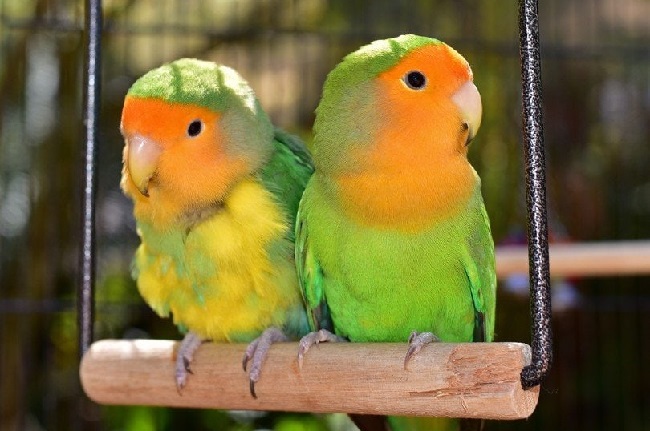Lovebirds, belonging to the Agapornis genus, are captivating and colorful small parrots admired globally for their social nature and strong pair bonds, hence the name “Lovebirds”.
Their vibrant hues, varying species, and distinct tail types make them an intriguing subject. This article offers a detailed look into the various types of Lovebirds, unearthing the diverse world of these endearing creatures.

Understanding Lovebirds
Lovebirds originate from Africa and Madagascar, known for their strong monogamous bonds and the affectionate behavior they display towards their partners.
Read Also:
These petite parrots are highly social, intelligent, and energetic, and they come in a vast array of colors and species, each with unique traits and qualities.
Popular Types of Lovebirds by Species
Here are some of the popular species of love birds:
1. Peach-faced Lovebirds
Peach-faced Lovebirds, or Agapornis roseicollis, are the most common species kept as pets. They are recognized for their vivid green bodies, blue rumps, and rosy faces.
2. Fischer’s Lovebirds
Fischer’s Lovebirds (Agapornis fischeri) are known for their vibrant green body, bright red beak, and the distinctive orange-red around their neck and head.
3. Masked Lovebirds
Masked Lovebirds, also known as Black-masked Lovebirds or Agapornis personatus, sport a black face and throat, contrasting beautifully with their light green body.
4. Lilian’s (Nyasa) Lovebirds
The Lilian’s Lovebirds, or Nyasa Lovebirds (Agapornis lilianae), are primarily green, with a red forehead and an orange collar behind their neck.
Exploring the Hues of Lovebirds
Lovebirds come in a breathtaking palette of colors, thanks to their different species and selective breeding. Some striking variations include:
1. Blue Lovebirds
Blue Lovebirds, predominantly a mutation in Peach-faced Lovebirds, have a calming, sky-blue body.
2. Pied Lovebirds
Pied Lovebirds are a color mutation where the bird has patches of non-colored feathers, creating a striking contrast.
3. Lutino Lovebirds
Lutino Lovebirds, characterized by their warm yellow color, are a common sight in the pet trade. Their red eyes add to their charm.
Tail Variations in Lovebirds
Just as the colors and species vary, Lovebirds also come with unique tail designs. Some common tail types include:
1. Long-tailed Lovebirds
The Abyssinian, Red-headed, and Black-collared Lovebirds are often categorized as Long-tailed Lovebirds due to their extended tail feathers.
2. Short-tailed Lovebirds
Peach-faced, Fischer’s, and Masked Lovebirds fall under the category of short-tailed Lovebirds.
The Appeal of Lovebirds
Beyond their physical beauty, Lovebirds are known for their playful, energetic demeanor and deep bonding capacity. They are highly social and thrive with companionship, making them an excellent pet for bird enthusiasts.
Lovebird Care and Maintenance
Lovebirds, like any pet, require proper care and attention to thrive. Here are a few aspects to consider:
Feeding Lovebirds
Lovebirds are granivores, meaning their diet primarily consists of seeds. However, a seed-only diet can lead to malnutrition. Hence, it’s essential to supplement their diet with fresh fruits, vegetables, and specially formulated pellets.
Apple, carrot, broccoli, and leafy greens are popular choices. Avoid avocados and chocolate, as they can be toxic for these birds.
Housing Lovebirds
A spacious cage is vital for lovebirds as they are active creatures who need room to move around. A cage that is at least 24 inches long by 24 inches wide and 24 inches high is generally sufficient for a pair.
Bars should be no more than 1/2 inch apart to prevent the birds from sticking their heads through and potentially getting stuck.
Social Needs of Lovebirds
Lovebirds, true to their name, thrive on social interaction. They are known for forming strong bonds with their partners or their human caretakers.
If you only have one lovebird, you’ll need to provide plenty of interaction and enrichment to keep it from getting lonely. Toys, mirrors, and regular out-of-cage time can all help keep a single lovebird happy.
Health and Longevity
With proper care, lovebirds can live up to 15 years, sometimes even longer. Regular vet check-ups are essential to catch potential health issues early.
Signs of a healthy lovebird include bright eyes, clean feathers, and energetic behavior. Watch out for signs of illness, such as lethargy, ruffled feathers, loss of appetite, or changes in droppings.
Lovebirds as Pets: Are They Right for You?
Lovebirds make fantastic pets for the right person or family. They are social, affectionate, and their vibrant colors and playful personalities can bring a lot of joy.
However, they also require a considerable commitment in terms of care, time, and interaction. Understanding their needs is crucial before you decide to bring a lovebird into your home.
Read Also:
Conclusion
The dynamic world of Lovebirds is rich in diversity, with a plethora of species, colors, and tail types. Understanding these variations is essential when considering adopting these birds, ensuring you can cater to their unique needs and preferences.
Lovebirds, with their charming personalities and vibrant aesthetics, indeed live up to their name, bringing a dash of love and color to any home they enter.
























